Singapore’s 2022 GDP growth lower than advance estimates at 3.6%, 2023 forecast kept at 0.5-2.5%
SINGAPORE’S economy grew 3.6 per cent in 2022, revised down from January’s advance estimate of 3.8 per cent, data from the Ministry of Trade and Industry (MTI) showed on Monday (Feb 13).
This was slower than 2021’s 8.9 per cent growth rate, which has been revised upwards from the earlier figure of 7.6 per cent.
Fourth-quarter growth in gross domestic product (GDP) came in at 2.1 per cent year on year, revised down from the advance estimate of 2.2 per cent and moderating from the 4 per cent expansion in the third quarter.
On a quarter-on-quarter seasonally-adjusted basis, growth was a marginal 0.1 per cent, easing from 0.8 per cent in the third quarter.
The MTI kept its 2023 growth forecast range at 0.5 to 2.5 per cent, even though Singapore’s external demand outlook has improved “very slightly” since the last report in November, permanent secretary Gabriel Lim said in a media briefing on Monday.
“China’s faster-than-expected reopening from the Covid restrictions will definitely not just help benefit Singapore’s sectors – for example, tourism, aerospace and so on – but also uplift regional economies, which will in turn also have a positive second-order effect on Singapore,” he said.
This, however, ought to be seen in context of some of the other broader challenges and issues elsewhere, such as in the United States and the eurozone, he added.
The growth outlook for outward-facing sectors thus remains weak given the broader slowdown in the global economy, said MTI. Uncertainties remain, it added, including the risk of ”disorderly market adjustments” among major central banks and escalations in the Ukraine war as well as other geopolitical tensions.
Meanwhile, Singapore’s current monetary policy stance remains appropriate, said Edward Robinson, chief economist at the Monetary Authority of Singapore (MAS).
“The recent out-turns in inflation and growth have come somewhat closer in line with our expectations, and MAS’s next policy review accordingly is scheduled for April 2023,” he said. “The cumulative effects of the monetary policy tightening since October 2021 will slow the inflation momentum and ensure that price pressures do not become entrenched in the economy.”
Most economists said they were maintaining their growth outlook for now.
Barclays regional economist Brian Tan said he remains relatively more optimistic than the MTI, with a 2023 full-year growth forecast of 2.2 per cent, which he said is well above the 1.5 per cent midpoint of the official forecast range.
”While we expect manufacturing activity to remain weak into this year, the services sector recovery – driven by the revival in international travel – will likely provide a significant offset,” he said.
OCBC chief economist Selena Ling said the services sector is likely to continue to do the “heavy-lifting” from here, having contributed 3.2 per cent to real GDP growth last year.
However, she believes that a “choppy” growth trajectory is still likely in the first half of this year, as she believes China’s reopening, which bodes well for regional growth, may not be sufficient to offset the slowing demand from other major economies like the US, eurozone and United Kingdom.
“Moreover, the current semiconductor bout of weakness may last until H2 and prove a deadweight on electronics and manufacturing growth prospects at this juncture,” she said, adding that the geopolitical landscape remains volatile.
Sectoral performance
In the fourth quarter, the manufacturing sector shrank 2.6 per cent year on year, reversing from the 1.1 per cent growth in the previous quarter. This was due to declines in biomedical manufacturing, chemicals, electronics and general manufacturing.
But manufacturing was up on a quarter-on-quarter seasonally-adjusted basis, growing 1 per cent in a turnaround from Q3’s 2.9 per cent contraction.
The finance and insurance sector contracted by 0.3 per cent year on year in Q4, reversing from Q3’s 0.5 per cent growth. This was as contractions in banking and insurance more than offset expansions in fund management and “other auxiliary activities”.
But all other sectors grew year on year in Q4, with the highest growth seen in food and beverage services (19.6 per cent) real estate (15.2 per cent), administrative and support services (10.5 per cent) and construction (10 per cent).
On the whole, growth in 2022 was driven mainly by wholesale trade, manufacturing and other services sectors, said the ministry.
The manufacturing sector, which had kept the economy afloat during the Covid-19 pandemic, grew just 2.5 per cent for the full year, down from 13.3 per cent in 2021. All clusters saw expansion, except for chemicals and biomedical manufacturing.
The construction sector expanded 6.7 per cent, coming off a high base, with growth having been 20.5 per cent in the previous year.
The services industries grew 4.8 per cent, easing from the previous year’s 7.6 per cent expansion.
Source: https://www.businesstimes.com.sg/singapore/singapores-2022-gdp-growth-lower-advance-estimates-36-2023-forecast-kept-05-25


 English
English




